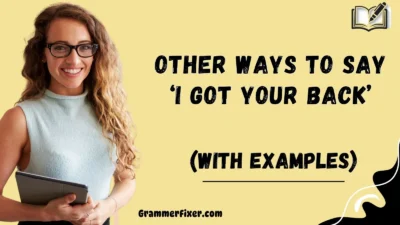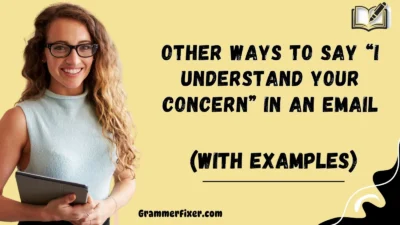Finding the right words when asking for help in an email can make the difference between sounding warm and respectful or unintentionally abrupt. A thoughtfully worded request not only gets your message across clearly but also shows that you value the recipient’s time, effort, and expertise.
The following alternatives will help you express yourself with empathy, professionalism, and care, making your emails feel more personal and meaningful.
What Does “Polite Ways to Ask for Help in an Email” Mean?
When we talk about polite ways to ask for help in an email, we mean phrasing your request in a way that shows respect, gratitude, and consideration. It’s about balancing clarity with kindness, ensuring your recipient feels appreciated rather than burdened.
When to Use “Polite Ways to Ask for Help in an Email”?
You should use these phrases when:
- Writing to a colleague, supervisor, or client about a specific project, report, or task.
- Seeking guidance, clarification, or expertise on a professional or personal matter.
- Addressing urgent or complex issues where the right tone can make the request smoother.
- You want to show gratitude in advance and maintain a positive professional relationship.
Is It Professional/Polite to Say “Polite Ways to Ask for Help in an Email”?
Yes, it is absolutely professional and polite. In fact, many employers and clients expect clear, respectful communication. By choosing your words carefully, you reduce the risk of miscommunication and show you value the recipient’s time and insights.
Pros or Cons
Pros
- Creates a positive impression.
- Encourages timely and thoughtful responses.
- Builds trust and respect with colleagues and clients.
- Reduces chances of being seen as demanding or inconsiderate.
Cons
- May take a little more time to draft thoughtfully.
- If overly formal, can feel distant or stiff in casual situations.
1. Could You Please Help Me With…
Meaning: A straightforward yet polite request.
Detailed Explanation: Using “could you please” shows respect and willingness, softening the request.
Scenario Example: “Could you please help me with the final edits of the financial report?”
Best Use: With colleagues or supervisors in a professional context.
Worst Use: In casual emails to friends or peers—it may sound overly formal and stiff.
Tone: Formal, respectful, and clear.
2. I Would Really Appreciate Your Guidance On…
Meaning: A warm way to express gratitude in advance.
Detailed Explanation: Highlights that their input is valued and important.
Scenario Example: “I would really appreciate your guidance on how to structure this presentation.”
Best Use: When addressing a mentor or senior colleague.
Worst Use: When making a small or simple request (like asking for a file)—it can feel too heavy for minor matters.
Tone: Grateful and thoughtful.
3. Would You Be Able to Assist Me With…
Meaning: A slightly formal phrase that shows deference.
Detailed Explanation: Positions the recipient as someone with the ability and expertise.
Scenario Example: “Would you be able to assist me with the data analysis section?”
Best Use: With superiors, managers, or respected colleagues.
Worst Use: In casual team chats or with close coworkers—can feel unnecessarily formal and distant.
Tone: Polite, formal, professional.
4. I’m Wondering If You Could Help Me With…
Meaning: Shows curiosity and humility.
Detailed Explanation: A softer way of phrasing, feels less demanding.
Scenario Example: “I’m wondering if you could help me with clarifying the project’s next steps.”
Best Use: When requesting clarification, advice, or small favors.
Worst Use: In urgent situations—may feel too hesitant or unsure when speed and clarity are required.
Tone: Gentle, respectful, approachable.
5. I’d Be Grateful If You Could…
Meaning: Conveys gratitude before the action is taken.
Detailed Explanation: Strongly emphasizes thankfulness and respect.
Scenario Example: “I’d be grateful if you could review this draft before tomorrow.”
Best Use: When urgency is involved but you want to remain kind and professional.
Worst Use: With peers in informal settings—may sound overly serious or old-fashioned.
Tone: Formal yet warm.
6. Could You Kindly Help Me With…
Meaning: Uses “kindly” to add an extra layer of courtesy.
Detailed Explanation: Works well in professional, formal contexts where showing respect and humility is important.
Scenario Example: “Could you kindly help me with updating the project’s status report?”
Best Use: When emailing clients, external partners, or higher authorities.
Worst Use: In casual, everyday work emails—“kindly” can sound old-fashioned or overly formal.
Tone: Formal, courteous, deferential.
7. May I Ask for Your Help With…
Meaning: A polite, slightly formal request showing respectful permission-seeking.
Detailed Explanation: Framed as a question, it softens the request and makes it feel considerate.
Scenario Example: “May I ask for your help with preparing the annual report presentation?”
Best Use: When writing to a superior, professor, or client where formality is valued.
Worst Use: With close colleagues or friends—may sound too stiff or unnecessarily formal.
Tone: Formal, respectful, thoughtful.
8. I’d Appreciate It If You Could…
Meaning: Shows advance gratitude for the recipient’s time and effort.
Detailed Explanation: Creates a tone of mutual respect, indicating that their support is valuable.
Scenario Example: “I’d appreciate it if you could share your feedback on the campaign draft by Friday.”
Best Use: In professional emails where you want to emphasize respect and appreciation.
Worst Use: For quick, casual favors—can sound too weighty for minor requests.
Tone: Warm, respectful, grateful.
9. Would You Mind Helping Me With…
Meaning: A softer request that suggests you don’t want to impose.
Detailed Explanation: Shows that you are mindful of their time and workload.
Scenario Example: “Would you mind helping me with fixing the formatting in this document?”
Best Use: When writing to coworkers or peers in a collaborative setting.
Worst Use: With clients or executives—it can sound slightly too casual or hesitant.
Tone: Polite, gentle, considerate.
10. If You Have a Spare Moment, Could You…
Meaning: A respectful way to recognize that the recipient’s time is valuable.
Detailed Explanation: Adds courtesy by acknowledging they may be busy.
Scenario Example: “If you have a spare moment, could you review the attached proposal?”
Best Use: When addressing colleagues or supervisors with non-urgent requests.
Worst Use: For urgent or time-sensitive tasks—suggests flexibility when you actually need quick action.
Tone: Respectful, humble, mindful.
11. I Hope It’s Not Too Much Trouble, But Could You…
Meaning: Shows empathy and acknowledges that your request may cause extra effort.
Detailed Explanation: Helps soften the request by showing awareness of potential inconvenience.
Scenario Example: “I hope it’s not too much trouble, but could you resend the missing data files?”
Best Use: When asking for something that could take extra effort.
Worst Use: With very small or trivial requests—can make it seem like you’re exaggerating the difficulty.
Tone: Empathetic, warm, caring.
12. I’m Reaching Out to Ask If You Could…
Meaning: Frames the request as a purposeful act of communication.
Detailed Explanation: Works well in formal emails where you want to sound professional but approachable.
Scenario Example: “I’m reaching out to ask if you could provide feedback on the marketing plan.”
Best Use: With clients, senior colleagues, or external contacts.
Worst Use: In very casual settings (e.g., emailing a friend)—it may feel too corporate.
Tone: Professional, neutral, polite.
13. I’m Seeking Your Guidance On…
Meaning: A respectful way of asking for direction or expertise.
Detailed Explanation: Puts the emphasis on the recipient’s knowledge and authority, showing trust in their abilities.
Scenario Example: “I’m seeking your guidance on how best to address this client’s concerns.”
Best Use: When contacting a mentor, professor, or senior colleague.
Worst Use: For minor tasks (like scheduling a meeting)—can feel too formal or exaggerated.
Tone: Respectful, professional, admiring.
14. I’d Value Your Input On…
Meaning: Positions the recipient’s opinion as important and respected.
Detailed Explanation: Shows you see them as a valued contributor, not just someone doing you a favor.
Scenario Example: “I’d value your input on the draft for the new policy proposal.”
Best Use: In collaborative projects where the recipient’s insights are truly significant.
Worst Use: If you don’t actually plan to use their input—could feel insincere.
Tone: Professional, appreciative, inclusive.
15. Could I Trouble You For…
Meaning: A courteous way of saying you know you’re asking for their time.
Detailed Explanation: Adds a touch of humility, recognizing that your request might interrupt their work.
Scenario Example: “Could I trouble you for a quick review of this email draft before I send it out?”
Best Use: When the favor is small but meaningful.
Worst Use: For large, time-consuming tasks—it downplays the effort required.
Tone: Polite, humble, slightly formal.
16. I’d Be Thankful If You Could…
Meaning: Expresses gratitude upfront in a warm tone.
Detailed Explanation: Similar to “I’d be grateful,” but slightly more casual and personable.
Scenario Example: “I’d be thankful if you could share the updated project timeline.”
Best Use: With colleagues or peers where warmth is appropriate.
Worst Use: In very formal business settings—may come across as too casual or personal.
Tone: Warm, respectful, appreciative.
17. I’m Hoping You Might Assist Me With…
Meaning: Uses hope to show humility and optimism in asking.
Detailed Explanation: Conveys that you’re not demanding, but rather inviting their help.
Scenario Example: “I’m hoping you might assist me with preparing the slides for tomorrow’s presentation.”
Best Use: When writing to a friendly colleague, manager, or mentor.
Worst Use: When addressing strictly formal recipients—“hoping” may sound uncertain or less professional.
Tone: Gentle, kind, respectful.
18. Would You Kindly Share Your Thoughts On…
Meaning: Requests feedback in a way that’s polite and deferential.
Detailed Explanation: Shows that their opinions and perspectives are highly valued.
Scenario Example: “Would you kindly share your thoughts on the attached proposal draft?”
Best Use: When asking for feedback, opinions, or evaluations.
Worst Use: For urgent, practical help (e.g., “Would you kindly share your thoughts on fixing the printer?”)—sounds mismatched.
Tone: Formal, respectful, appreciative.
19. I’d Love Your Advice On…
Meaning: A warm, engaging way to request guidance or perspective.
Detailed Explanation: Shows you see the recipient as someone whose opinion truly matters.
Scenario Example: “I’d love your advice on how to prioritize tasks for the upcoming project launch.”
Best Use: With mentors, colleagues, or trusted managers where the relationship is friendly.
Worst Use: In very formal or hierarchical settings—“love” can feel too casual.
Tone: Warm, approachable, appreciative.
20. Could You Lend Me Your Expertise On…
Meaning: Recognizes the recipient’s skill and knowledge.
Detailed Explanation: By asking them to “lend expertise,” you show deep respect for their abilities.
Scenario Example: “Could you lend me your expertise on interpreting this financial analysis?”
Best Use: When reaching out to someone with specialized knowledge.
Worst Use: For minor tasks or general requests—may come across as over-the-top.
Tone: Professional, respectful, admiring.
21. I’m Hoping to Get Your Perspective On…
Meaning: Invites the recipient to share their unique viewpoint.
Detailed Explanation: Positions the person as someone whose perspective adds real value.
Scenario Example: “I’m hoping to get your perspective on the strategy for next quarter’s marketing campaign.”
Best Use: With team leaders or colleagues during brainstorming or planning.
Worst Use: When requesting urgent technical help (e.g., fixing an error)—too indirect.
Tone: Open, collaborative, thoughtful.
22. I’d Be Immensely Grateful If You Could…
Meaning: Strongly emphasizes your thankfulness.
Detailed Explanation: Adds weight to your request by showing you’ll truly value the help.
Scenario Example: “I’d be immensely grateful if you could connect me with your contact at the research institute.”
Best Use: For favors requiring effort or personal connections.
Worst Use: For small, routine requests—can feel exaggerated.
Tone: Formal, heartfelt, respectful.
23. If It’s Convenient, Could You…
Meaning: A polite way to acknowledge the recipient’s schedule and priorities.
Detailed Explanation: Shows you’re considering their time and don’t want to impose.
Scenario Example: “If it’s convenient, could you share the updated budget file?”
Best Use: When asking for something that’s helpful but not urgent.
Worst Use: In time-sensitive situations—suggests flexibility when urgency is needed.
Tone: Considerate, polite, flexible.
24. I’d Greatly Appreciate Your Assistance With…
Meaning: A formal, gracious way of expressing advance gratitude.
Detailed Explanation: Highlights the value of their support while remaining professional.
Scenario Example: “I’d greatly appreciate your assistance with compiling the quarterly performance data.”
Best Use: In formal business communication where professionalism is key.
Worst Use: In casual emails with coworkers—may sound overly stiff.
Tone: Formal, appreciative, respectful.
25. I’m Reaching Out in Hopes You Could…
Meaning: Frames the request as a purposeful outreach while showing humility.
Detailed Explanation: Signals that you value the act of communication itself and are hopeful for support.
Scenario Example: “I’m reaching out in hopes you could provide insights into the client feedback summary.”
Best Use: For semi-formal messages to colleagues, managers, or clients.
Worst Use: In very casual requests (e.g., “I’m reaching out in hopes you could help with the coffee order”)—too formal for small tasks.
Tone: Professional, hopeful, considerate.
26. I’d Appreciate Any Help You Can Provide With…
Meaning: Leaves the scope open, showing flexibility and gratitude.
Detailed Explanation: Acknowledges that the recipient may only be able to help partially, which makes it empathetic.
Scenario Example: “I’d appreciate any help you can provide with troubleshooting this system error.”
Best Use: When you’re unsure how much the recipient can contribute.
Worst Use: In formal proposals—“any help” can sound vague or less professional.
Tone: Flexible, polite, humble.
27. Could You Assist Me in Resolving…
Meaning: Requests direct help in solving a problem.
Detailed Explanation: Emphasizes resolution and problem-solving, not just assistance.
Scenario Example: “Could you assist me in resolving the login issue that several users are facing?”
Best Use: For technical, process, or problem-oriented requests.
Worst Use: In casual contexts—can feel overly formal when a simpler phrase would work.
Tone: Professional, clear, solution-focused.
28. I’m Writing to Ask If You Could…
Meaning: Direct but still professional and polite.
Detailed Explanation: Useful when the purpose of your email is purely to request help.
Scenario Example: “I’m writing to ask if you could review my attached draft report.”
Best Use: In formal email correspondence with external contacts.
Worst Use: For quick, internal messages where formality is unnecessary.
Tone: Clear, formal, respectful.
29. Your Support Would Make a Big Difference With…
Meaning: Highlights how important their help is to the outcome.
Detailed Explanation: Expresses that their support is impactful and appreciated.
Scenario Example: “Your support would make a big difference with finalizing the client presentation.”
Best Use: For motivational requests that require teamwork.
Worst Use: For tiny tasks (e.g., “Your support would make a big difference with stapling these papers”)—feels exaggerated.
Tone: Encouraging, appreciative, motivating.
30. I’m Reaching Out for Your Assistance With…
Meaning: Combines politeness and professionalism into a direct request.
Detailed Explanation: Suitable for a variety of professional situations, making it versatile.
Scenario Example: “I’m reaching out for your assistance with preparing the monthly sales report.”
Best Use: When contacting colleagues, clients, or partners formally.
Worst Use: In friendly, informal exchanges—may sound unnecessarily corporate.
Tone: Polite, professional, flexible.
Conclusion
Asking for help in an email is not always easy—sometimes you want to sound professional and respectful, while other times you hope to come across as warm and approachable. The good news is that the words you choose can make all the difference.
These 30 polite alternatives provide you with a flexible toolkit to adapt your message depending on the situation, recipient, and level of formality required. Each phrase has its strengths and weaknesses, and knowing the best use and worst use helps you avoid sounding too casual in formal settings or too formal in casual ones.



